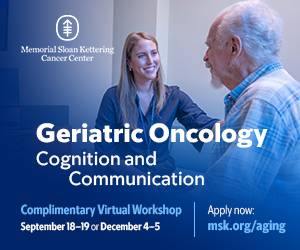|
E-Newsletter • August 2025 |
▼ ADVERTISEMENT

Editor's E-Note
Research published in The Gerontologist explores the otherwise unknown link between autism-spectrum traits and the decline in memory that comes with age. This month’s exclusive dives into the details.
In addition to reading our e-newsletter, be sure to visit Today’s Geriatric Medicine’s website at www.TodaysGeriatricMedicine.com, where you’ll find news and information that’s relevant and reliable. We welcome your feedback at TGMeditor@gvpub.com. Follow Today’s Geriatric Medicine on Facebook and X, formerly known as Twitter, too.
— Josh Hildebrand, editor |
|
|
|
▼ ADVERTISEMENT
 |
▼ ADVERTISEMENT

The Association Between Autism Spectrum Traits and Age-Related Spatial Working Memory Decline
Autism is a lifelong set of highly heritable heterogeneous neurodevelopmental conditions characterized by differences in social communication and repetitive patterns of sensory-motor behaviors. Recent estimates suggest that autism has a global prevalence of ~1% (Santomauro et al, 2024).
However, due to historical changes to the diagnostic criteria for autism (eg, from a narrow to wide diagnostic criteria, historically being a predominantly male diagnosis), many people remain undiagnosed (Happé & Frith, 2020; Lai & Baren Cohen, 2015). For example, a study using United Kingdom health care records found that only 1 in 18,000 adults over the age of 50 had an autism diagnosis in 2018, suggesting that only one in nine autistic people in this age group are diagnosed (O’Nions et al, 2023). Additionally, due to these changes in diagnostic criteria and the high rates of underdiagnosis in older populations, we know little about the needs of autistic people as they age (Mason et al, 2022).
▼ ADVERTISEMENT

Autism is often viewed as being part of a spectrum, where it exists at the end of a continuum of high to low autistic traits found in the general population (Constantino & Todd, 2003; Hoekstra et al, 2007). Additionally, these traits are found to have strong genetic overlap with diagnosed autism (Bralten et al, 2018). Furthermore, classifying autistic traits as natural human variations existing on a continuum, as opposed to medical deficits, also aligns with the neurodiversity perspective, which returns autonomy to the autistic community regarding their care and acknowledges not only differences but also strengths associated with autism (Kapp et al, 2013). As such, using a dimensional trait-based approach to study autism has become increasingly common, particularly in historically overlooked populations, for example, women/girls, and older people. The effectiveness of this approach is also strengthened by growing evidence that individuals with high autistic traits are often found to have similar social, health, and cognitive profiles to diagnosed autistic samples (Stewart et al, 2020, 2021, 2023). Taken together, studying autistic traits in older age is a convenient way to bridge two high-priority public health issues—understanding the needs of neurodivergent people, and understanding the needs of older people.
|
▼ ADVERTISEMENT

Cats Could Aid in Studying Alzheimer’s
Researchers at the University of Edinburgh learned of the shocking similarities between the brain toxins in cats with dementia and those in the brains of older adults with the same condition. Their research is available in the European Journal of Neuroscience.
Increasing Effectiveness of Geriatric Assessments in Cancer Patients
Because geriatric assessments (GAs) can take time to complete, oncologists often forgo them. However, a new, free tool is improving the time GAs take to complete to make them more useful to oncologists, especially when it comes to patients with cancer.
Improving Communication
Improving health information exchange between hospitals and skilled nursing facilities may improve the readmission rate of long term care patients with heart failure, according to a study published in BMC Health Services Research.
A Single Protein Can Cause Aging to Spread
Researchers from the Korea University College of Medicine have discovered that a protein is able to spread through the bloodstream, triggering senescence in cells. Their study is published in Metabolism. |
New Study Using Aptar’s Nasal Drug Delivery System Validates Insulin Nasal Spray to Deliver Alzheimer’s Drug Directly to the Brain
AptarGroup, Inc, recently announced that its nasal drug delivery system was used in a recently published brain imaging study from Wake Forest University School of Medicine. According to the university’s press release, the “groundbreaking” study confirms a vital step toward new Alzheimer’s treatments: intranasal insulin, delivered via nasal spray, safely and effectively reaches key memory regions of the brain in older adults. The study also revealed that people with early cognitive decline may absorb it differently.
This research, published in Alzheimer’s & Dementia: Translational Research & Clinical Interventions, describes the results of a milestone positron emission tomography (PET) imaging study. According to the Wake Forest team, the results directly show that intranasal insulin travels to 11 key brain regions associated with memory and cognition. Previously, researchers faced challenges in earlier intranasal insulin trials because they could not confirm if the treatment was reaching its brain targets.
|
|
|
COVER STORY
The Late-Onset Allergy Puzzle
Food allergies aren’t just a childhood issue. They can emerge later in life and often go undiagnosed in older adults. Learn why recognizing and managing food allergies in aging populations is becoming increasingly vital for geriatric care teams.
FEATURE
Shingles’ Psychological Impact
Shingles isn’t just a painful rash—it’s a serious illness that can affect one in three adults, especially as they age. Learn how this often-overlooked condition can impact older adults’ physical and mental health—and what providers need to know.
|
|
|
| Advertising Opportunities |
Have a product or service you want to market to geriatric care professionals? Utilize the reach of Today's Geriatric Medicine Magazine to accomplish your marketing goals. Email our experienced account executives today at sales@gvpub.com or call 800-278-4400 for more information.
|
| © 2025 Today's Geriatric Medicine Magazine |
|
|